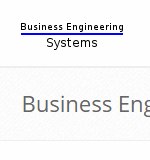Wealth and Welfare
New Standards of Success for the Growth and Development of Economies and Enterprises
The intrinsic growth determines the future of enterprises and economies
This content is part of
"Project NEMO" (New/Next Economic Model) goto "Project NEMO"
"INSEDE" (Institute for Sustainable Economic Development) goto "INSEDE"
"Business Engineering Systems" goto "Business Engineering Systems", the tools
Read more about the Basics of Measuring Performance in a Knowledge Economy:
Linking Subjective and Objective Measurement into a "Vector-Based" Concept for Performance Measurement goto Measuring Performance
Permalink (download this paper as pdf):
English: https://bengin.net/permalink/gvp_V4.01_e.pdf
German: https://bengin.net/permalink/gvp_V4.01_d.pdf
Hybrid: https://bengin.net/permalink/gvp_V4.01_de.pdf
Authors:
Peter Hochreutener, Hiconsult GmbH, Switzerland
Peter Bretscher, Ingenieurbüro für Wirtschaftsentwicklung, Eggersriet, Switzerland,
Abstract
For whole economies, regions and enterprises it is a question of marking the field of growth chances with its limits and potentials. The own strengths, chances, and potentials, but also the weaknesses, risks and traps have to be estimated to the extent, that allows the derivation of economic, enterprise and sociopolitical strategies as well as the necessary general conditions.
The classic "extrinsic" growth of wealth of the GDP's has to be redefined and extended by the "intrinsic" possibilities of growth in the direction of sustainability and welfare. On the path of growth of the GDP's towards higher valued Gross Value Products GVP's, existing traps and obstacles have to be not only overcome, but overcompensated, if the balance shall be positive. To these factors of encumbrance or stress belong, among others, the supply trap caused by bottlenecks of raw material, the environmental damage and the disposal of waste trap, the productivity and equimarginal trap due to jobs which become obsolete, jobs of which we have, according to an ILO study, a global gap of 440 million, the trap of lacking purchasing power, due to a suboptimal dispersion of goods or the badly disregard of the equimarginal principle, the demographic development trap, together with the social impoverishment trap, the meanwhile global infrastructural trap due to overaged or missing prerequisites for an efficient economic development, the indebtedness trap, including the non covered pension engagements, the stability trap of no longer functioning leadership systems, the innovation trap due to the technical progress, the image and confidence trap, and the welfare bleakness trap, which is nothing else than an creeping cutback of welfare to the debit of the present and of future generations.
It is unthinkable to correctly offset the growth of welfare with the charges of these complex stress factors. But every country or region and every enterprise can make an extended estimation of its economic results in order to show its Gross Value Product GVP or a holistic enterprise value respectively, from which follow the true value of its potentials as well as of the direction of its development.
List of Content
- Wealth and Welfare, the course of the economic growth
- The Gross Domestic Product (GDP) measures the wealth but not the welfare:
- The Gross Domestic Product GDP should be supplemented by the Gross-Welfare-Product GWP:
- The "Extrinsic" Social Product (ESP) reflects the potential of the GDP to generate wealth.
- The "Intrinsic" Social Product (ISP) reflects the realized potential of the GDP to generate welfare.
- The Gross-Value-Product (GVP) measures the whole value of the economic output.
- The Gross Domestic Product GDP is subject to the law of a diminishing marginal utility.
- The allocation of the use-value of goods influences the total use-value according to the "equimarginal" principle:
- The ESP-Index is identical with the GDP-Index.
- The ISP-Index reflects the "intrinsic" additional use of goods and services:
- The ESP-ISP Total-Value-Index – the Gross-Value-Product (GVP) – of economies is a holistic index for sustainable growth:
- The ten (10) Traps:
- The supply trap
- The infrastructure trap
- The environmental damage trap
- The productivity- and equimarginal-trap
- The demographic- and social-trap
- The finance- and indebtedness-trap
- The leadership-, management- and stability-trap
- The innovation-trap
- The image- and confidence-trap
- The welfare-bleakness-trap
- The determination of the Gross-Value-Product GVP on the base of the statistical Gross-Domestic-Product GDP
- Summary:
- Digest and Authors
The course of the economic growth
From the straight forward escape to the upwards growth. The question of the limits of growth goes back to the times of pure quantitative, one-dimensional thinking. This orientation was always easily attackable, as well as from the viewpoints of the scarcity of raw material and the law of the diminishing marginal utility of the unlimited consumption as of the problems of the disposal of waste.
The fact that growth, as a natural prerequisite for survival can also have a qualitative dimension, was only considered seriously from the moment on, when diverse limits of pain were reached. Measuring however is, due to the lack of innovative methods, still done on a purely quantitative basis, by means of the easily accessible data of the Gross Domestic Product (GDP). This although the most promising growth markets for enterprises and whole economies lie in the qualitative growth.
Those enterprises and economies, which develop qualitative growth strategies and which are able to measure the use-values with indexes that include criteria of high quality of live in the broadest sense, will survive and sustainably prosper.
When you can measure what you are speaking about, and express it in numbers, you know something about it;
Lord Kelvin
but when you cannot measure it, when you cannot express it in numbers, your knowledge is of a meagre and unsatisfactory kind;
it may be the beginning of knowledge, but you have scarcely in your thoughts advanced to the state of Science, whatever the matter may be.
The Gross Domestic Product (GDP) measures the wealth but not the welfare:
Wealth reflects the income and the fortune.
The goods and services produced in a country and valued at market prices, are a measure for the development of wealth. Whether the welfare, the Gross-Welfare-Product (GWP), i.e. factors like social wellbeing, sustainability, quality of life and the like are linked to it, plays no role in the classic economic account. The GDP and its growth is an "extrinsic" monetary calculation.

Diagram 1 and 2
The Gross Domestic Product GDP should be supplemented by the Gross-Welfare-Product GWP:
Welfare is reflected in the emotionally felt Index for the additional "intrinsic" use-value linked with a product or a service.
The goods and services produced in a country, that besides the "extrinsic" monetary values generate additional "intrinsic" values of welfare, have to be rated higher in the economic account.
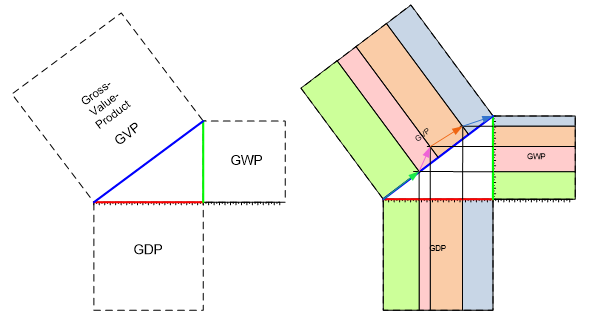
Diagram 3 and 4
Different GDP-Segments like agro, services, pharmacy... have different use-value-tags. They have a different impact in regard to wealth and welfare.

Diagram 5
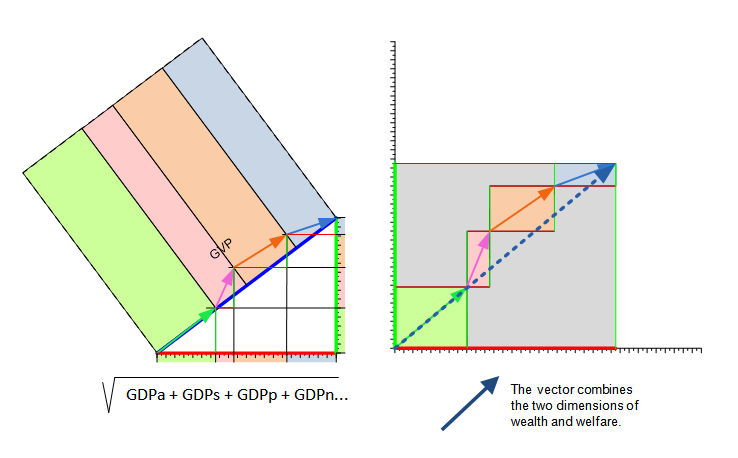
Diagram 6
The "Extrinsic" Social Product (ESP) reflects the potential of the GDP to generate wealth.
The ESP reflects the potential to cover the "extrinsic" needs of an economy.
The ESP for example registers the production of packaging material. The ESP is subject to the law of tending to sinking prices when productivity rises.
The ESP = GDP reacts to sinking prices when productivity rises, but not to a possible decrease of use-value when the consumption goes up.
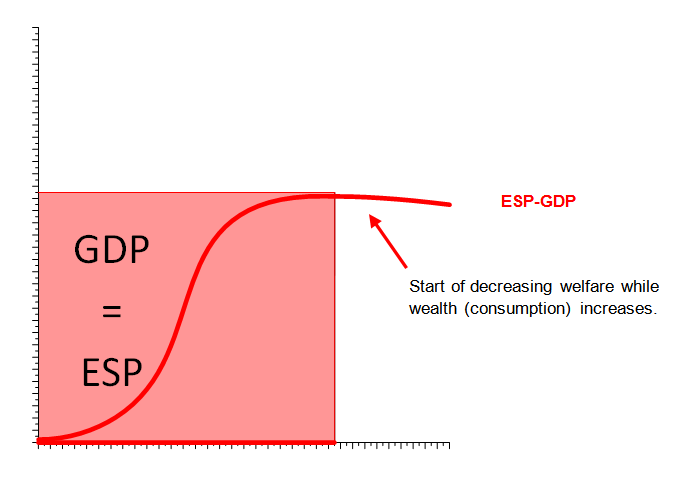
Diagram 7
The "Intrinsic" Social Product (ISP) reflects the realized potential of the GDP to generate welfare.
"Intrinsic" values are only recorded in the GDP when these additional use-values are honored in the market with higher prices, but not if e.g. any damage caused by the products is externalized or beard by others.
The ISP reflects the potential of the GDP to satisfy the "intrinsic" needs of welfare, for environmental protection, health, wellbeing, care and the like. The ISP attaches an independent importance e.g. to the recyclability of packaging material, the absence of pesticides in products or the use of a service for the society. The growth of the ISP goes together with a rising quality of life, tends to have a non-mechanical cost-dynamism and follows psychological mechanisms of prices.

Diagram 8
The Gross-Value-Product (GVP) measures the whole value of the economic output.
The Gross Value Product (GVP) is shown as the sum of the two areas.
The comparison of the economic growth over time and in the international context is only conclusive, if the GVP's are facing each other.
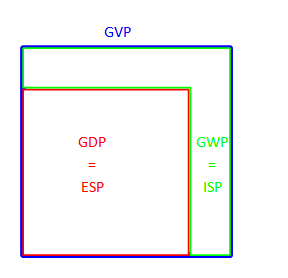
Diagram 9
The Gross Domestic Product GDP is subject to the law of a diminishing marginal utility.
The additional "marginal" utility of an extension by one product or service unit is called marginal utility. A diminishing marginal utility of an "extrinsic" growth is not registered in the GDP-ESP.
If the consumption of an additional unit generates no improvement of the "intrinsic" wellbeing, the marginal utility of the additional consumption is decreasing. If the marginal utility gets negative, e.g. due to environmental damage being caused, the total use-value can become negative.
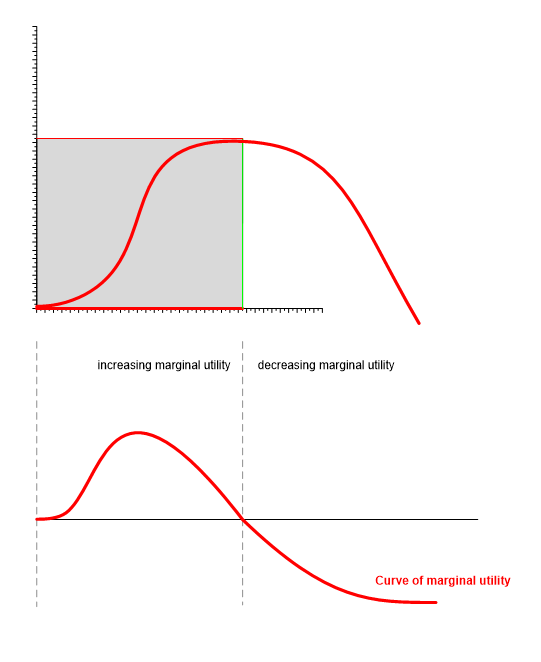
Diagram 10
The allocation of the use-value of goods influences the total use-value according to the "equimarginal" principle:
The GDP-ESP does not consider the effects of suboptimal use-value allocations.
The total use-value generated by a quantity of goods can be increased by way of a clever balance of consumption and allocation. According to this principle priorities for bottleneck-needs with a high marginal utility make sense. In combination with the satisfaction of "intrinsic" needs, a multiple total use-value can be achieved. This principle is valid in the individual context as well as for a whole economy.

Diagram 11
The ESP-Index is identical with the GDP-Index.
GDP-ESP Indexes do not reflect sustainable effects of products and services.
ESP- and GDP-Indexes are the solid, periodically and geographically well documented basis for the calculation of the potential and the growth of economies.
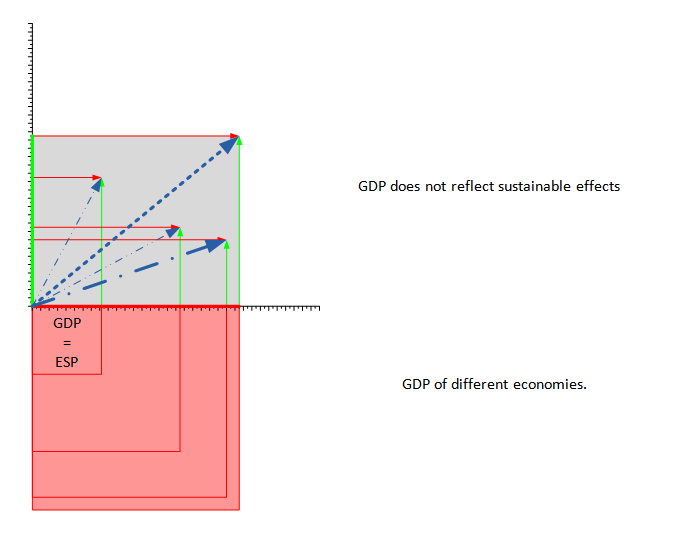
Diagram 12
The ISP-Index reflects the "intrinsic" additional use of goods and services:
The ISP-Index maps the "intrinsic" additional use-value which is not reflected in the pure market prices.
The "intrinsic" use-value of factors like energy-saving, environmental considerations, food supplying, saving health costs, taking care of people, social relief, education and the like are not linked to periods, locality or time. The ISP additional use-value can rise without causing costs and multiply itself independently from the ESP-Index. The ISP-Index consists of measurable or estimated multiples of the ESP-Indexes.

Diagram 13
The ESP-ISP Total-Value-Index – the Gross-Value-Product (GVP) – of economies is a holistic index for sustainable growth:
Economies with similar "extrinsic" oriented ESP-GDP Indexes do not inevitably produce the same feelings of use-value.
For a true comparison of sustainable growth of different economies, the classic Index of the GDP-growth has to be upgraded to an ESP-ISP Gross-Value-Index, which includes besides the monetary growth of wealth the intrinsic use-value of welfare.
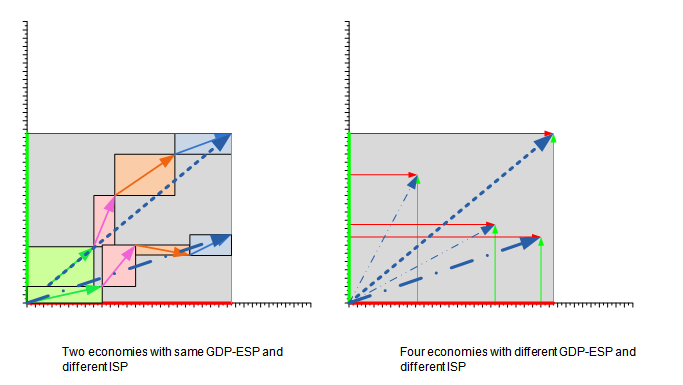
Diagram 14
The ten (10) Traps:
Traps:

Diagram 15
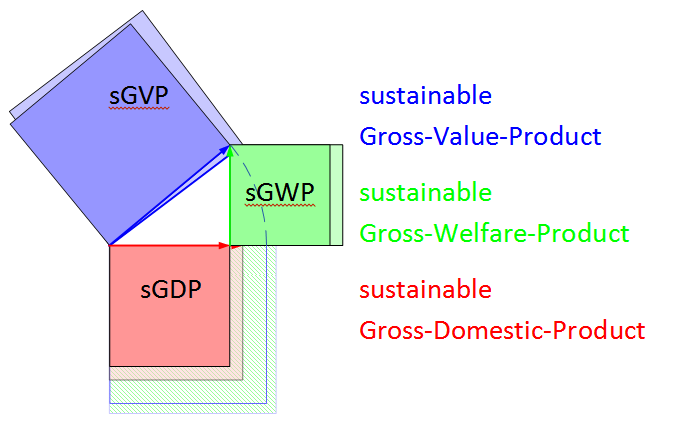
Diagram 16
Traps:
- The supply trap with raw material, water, food and effective technologies:
The GDP-ESP reflects the wealth without considering the threat through the growing scarcity of raw material, waterresources and foodbases or obsolete technologies. To keep the Gross-Value-Product GVP, including the "intrinsic" Social Product ISP, at a constant level, the economies and the enterprises confronted with this phenomenon, have to cushion this danger by replacing outdated technologies and with raw material-substitutions, investments in new hydro- and food-technologies or renewable raw material and energy. If they do not or cannot, the GDP shown is not sustainable or has to be valued as sGDP comparatively lower. - The infrastructure trap:
The GDP-ESP reflects wealth without considering the threat through missing, decaying or overaged infrastructures or the development of slums. To keep the Gross-Value-Product GVP, including the "intrinsic" Social Product ISP, at a constant level, the economies and the enterprises confronted with this phenomenon, have to cushion this danger by the construction or renewal of infrastructures and/or measures of city planning and construction. If they do not or cannot, the GDP shown is not sustainable or has to be valued as sGDP comparatively lower. - The environmental damage trap
The GDP-ESP reflects the wealth without considering the threat through environmental pollution, unsolved problems of the disposal of waste, waste water and land erosions. To keep the Gross-Value-Product GVP, including the "intrinsic" Social Product ISP, at a constant level, the economies and the enterprises confronted with this phenomenon, have to cushion this danger by intelligent technologies, plants for the disposal of waste, sewage purification plants, sewage systems and/or the use of recyclable or biodegradable raw material. If they do not or cannot, the GDP shown is not sustainable or has to be valued as sGDP comparatively lower. - The productivity- and equimarginal-trap
The GDP-ESP reflects the wealth without considering the implications of the diminishing marginal utility in the course of rising consumption by a limited consumer segment. The productivity trap can also lead to structural problems of employment. To keep the Gross-Value-Product GVP, including the "intrinsic" Social Product ISP, at a constant level, the economies and the enterprises confronted with this phenomenon, have to compensate this loss of use-value by the development of new markets or customer segments with equimarginal i.e. dispersed purchasing power. Politicians have to encounter structural problems of the labour markets as a result of rising productivities by suitable labour market policies. If they do not or cannot, the GDP shown is not sustainable or has to be valued as sGDP comparatively lower. - The demographic- and social-trap
The GDP-ESP reflects the wealth without considering the pressure through demographic and social developments, the lack of professional specialists, and the impoverishment or disintegration of broad segments of the population and epidemic diseases. To keep the Gross-Value-Product GVP, including the "intrinsic" Social Product ISP, at a constant level, the economies and the enterprises confronted with this pressure, have to compensate it with adequate educational policies, social systems, integration programs and medical care. If they do not or cannot, the GDP shown is not sustainable or has to be valued as sGDP comparatively lower. - The finance- and indebtedness-trap
The GDP-ESP reflects the wealth without considering the burden of the indebtedness into which they entered to finance the infrastructure, the production plants and/or the consumption. Uncovered pension schemes and missing provision systems are also part of the finance- and indebtedness trap. To keep the Gross-Value-Product GVP, including the "intrinsic" Social Product ISP, at a constant level, the economies and the enterprises confronted with this charge, have to cushion it by cost-reductions, a higher efficiency, more effective technologies and procedures, lean structures, the development of provision systems and higher receipts. If they do not or cannot, the GDP shown is not sustainable or has to be valued as sGDP comparatively lower. - The leadership-, management- and stability-trap
The GDP-ESP reflects wealth without considering shocks and losses due to leadership failure, management errors, system instabilities, hostilities, security problems, organised criminality, terror- and trouble spots. To keep the Gross-Value-Product GVP, including the "intrinsic" Social Product ISP, at a constant level, the economies and the enterprises confronted with this charge, have to compensate it by replacements, restructurings, control-, security- and legal systems, ceasing of hostilities and the like. If they do not or cannot, the GDP shown is not sustainable or has to be valued as sGDP comparatively lower. - The innovation-trap
The GDP-ESP reflects wealth without considering the technical progress, the intensification of the international competition and price fights, the increasing mobility of the production factors, the making of heavier demands and the change in the habits of consumption. To keep the Gross-Value-Product GVP, including the "intrinsic" Social Product ISP, at a constant level, the economies and the enterprises confronted with this charge, have to compensate it by automation, adaptations in the design, improvements of the effectiveness of products, the flexibility of the production and the supply management, the creation of non-exportable jobs, the expansion of the sales organization and trading structures, the development of cultures of innovation and the like. If they do not or cannot, the GDP shown is not sustainable or has to be valued as sGDP comparatively lower. - The image- and confidence-trap
The GDP-ESP reflects wealth without considering the accelerating exchange of information, the possibility to compare performance- and quality-standards at any time, the transparency of product- and achievement-references, the growing need for dependability and service guarantee, the market-behavior and -appearance. To keep the Gross-Value-Product GVP, including the "intrinsic" Social Product ISP, at a constant level, the economies and the enterprises confronted with this charge, have to compensate it by an intensified customer communication, the readiness for service at all levels, by guarantee funds, standards of fair dealing, the coordination between public and private trade and economic promotion organizations and last but not least by dependable, transparent trading- and legal-systems, free of corruption and the like. If they do not or cannot, the GDP shown is not sustainable or has to be valued as sGDP comparatively lower. - The welfare-bleakness-trap
The GDP-ESP reflects the wealth without considering the creeping cutback of welfare in segments like public service, health, schools, traffic, administration, up to air-, water- and noise-pollution. To keep the Gross-Value-Product GVP, including the "intrinsic" Social Product ISP, at a constant level, the economies and the enterprises confronted with this phenomenon, have to cushion this sort of loss of life quality by way of political and entrepreneurial "intrinsic" turn around measures. If they do not or cannot, the GDP shown is not sustainable or has to be valued as sGDP comparatively lower.
The determination of the Gross-Value-Product GVP on the base of the statistical Gross-Domestic-Product GDP
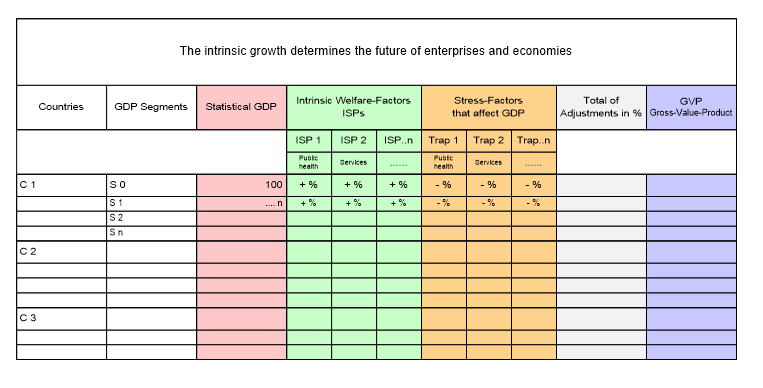
Diagram 17
The statistical GDP data which decide the global ranking, serve as a base for the determination of the Gross-Value-Product GVP of individual countries, possibly segmented in separate economic sectors. The intrinsic welfare factors increase the value of the GDP by the Intrinsic Social Products ISP, which have to be estimated as a percentage of the GDP, while the estimated stress factors that affect the GDP, diminish the sustainable value of the GDP. The sustainable Gross-Value-Product sGVP, which results in a new global ranking, corresponds to the statistical GDP, adjusted by the balance of the positive welfare factors and the negative stress factors or economic traps of the GDP respectively.
Summary:
For whole economies, regions and enterprises it is a question of marking the field of growth chances with its limits and potentials. The own strengths, chances, and potentials, but also the weaknesses, risks and traps have to be estimated to the extent, that allows the derivation of economic, enterprise and sociopolitical strategies as well as the necessary general conditions.
The classic "extrinsic" growth of wealth of the GDP's has to be redefined and extended by the "intrinsic" possibilities of growth in the direction of sustainability and welfare. On the path of growth of the GDP's towards higher valued Gross Value Products GVP's, existing traps and obstacles have to be not only overcome, but overcompensated, if the balance shall be positive. To these factors of encumbrance or stress belong, among others, the supply trap caused by bottlenecks of raw material, the environmental damage and the disposal of waste trap, the productivity and equimarginal trap due to jobs which become obsolete, jobs of which we have, according to an ILO study, a global gap of 440 million, the trap of lacking purchasing power, due to a suboptimal dispersion of goods or the badly disregard of the equimarginal principle, the demographic development trap, together with the social impoverishment trap, the meanwhile global infrastructural trap due to overaged or missing prerequisites for an efficient economic development, the indebtedness trap, including the non covered pension engagements, the stability trap of no longer functioning leadership systems, the innovation trap due to the technical progress, the image and confidence trap, and the welfare bleakness trap, which is nothing else than an creeping cutback of welfare to the debit of the present and of future generations.
It is unthinkable to correctly offset the growth of welfare with the charges of these complex stress factors. But every country or region and every enterprise can make an extended estimation of its economic results in order to show its Gross Value Product GVP or a holistic enterprise value respectively, from which follow the true value of its potentials as well as of the direction of its development.
Digest and Authors
Digest:
The authors disclose a systemic approach that makes it possible to simultaneously take into account wealth and welfare in the planning and development of economic and social systems and to find an integral optimum.
Schlussbemerkung:
Die Autoren stellen einen systemischen Ansatz vor, der es möglich macht, Wohlfahrt und Wohlstand in der Planung und Entwicklung von ökonomischen und sozialen Systeme simultan zu berücksichtigen und ein integrales Optimum zu finden.
Questions concerning the copyright should be addressed to the authors.
HiConsult GmbH | Dr. Peter Hochreutener | info@hiconsult.ch
Postfach 1729 | CH - 9001 St. Gallen | T: +41(0)71 230 14 15 | F: +41(0)71 222 17 07
Web: www.hiconsult.ch
Ingenieurbüro für Wirtschaftsentwicklung | Dipl. Ing. Peter Bretscher | peter.bretscher@bengin.com
Alpsteinstrasse 4 | CH - 9034 Eggersriet | T: +41(0)71 877 14 11 | M: +41(0)79 650 49 04
Web: www.bengin.net/bes/
Blog: www.bengin.net/wp/
Twitter: https://twitter.com/peterbretscher
This paper is part of Project NEMO (New/Next Economic Model): https://bengin.net/nemo and INSEDE (Institute for Sustainable Economic Development): https://insede.org
© 2010, 2014, all Rights Reserved, graphics are part of Business Engineering Systems, Registered Copyright TXu 512 154; 20. März 1992; derivative works and commercial use needs license.

